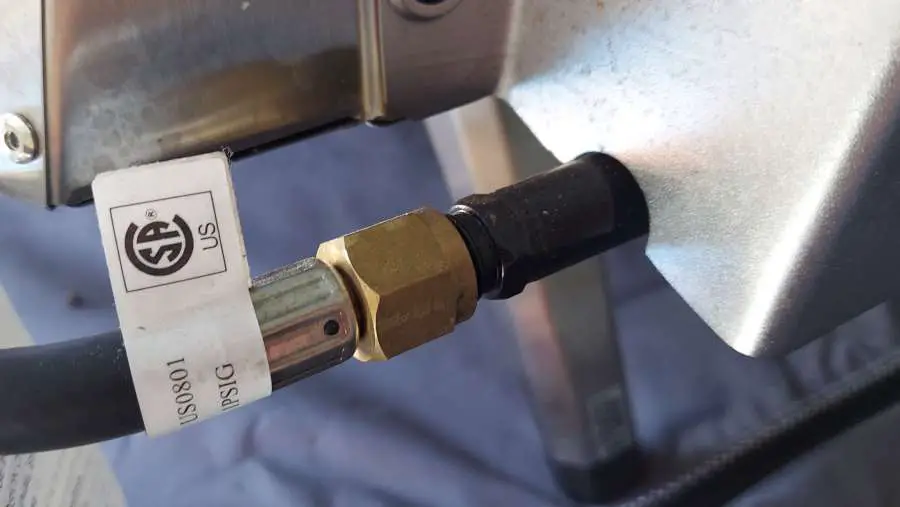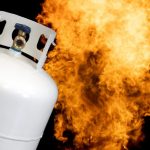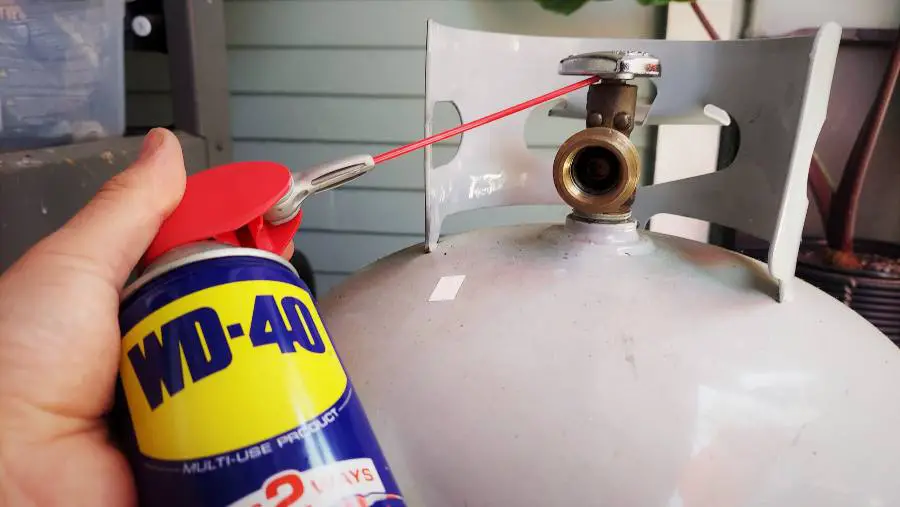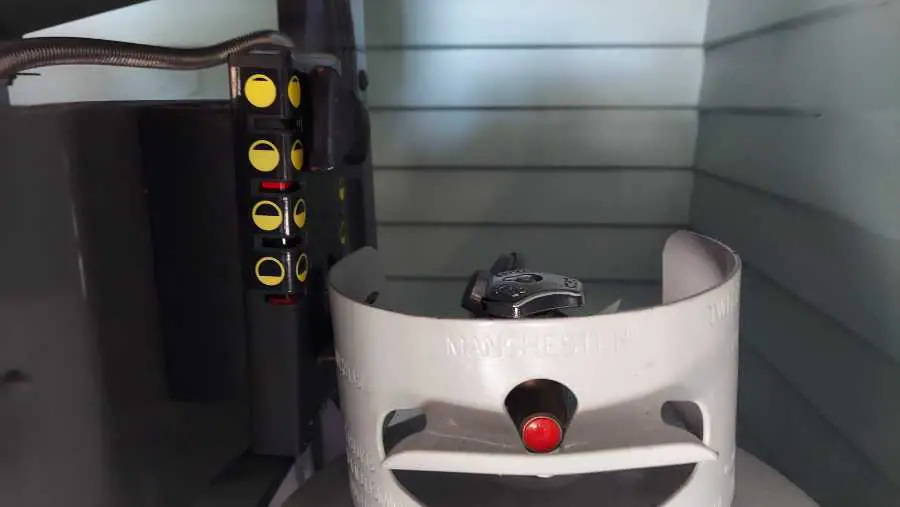Last Updated on May 23, 2024 by Dan Campbell
Ever wonder if you can lay a propane tank on its side? Well, whether it’s a 20 lb propane tank or a 100 lb propane tank, the propane inside is mostly in the form of a liquid and is kept at high pressure (typically between 100 and 200 psi). Because of this liquid propane, it’s important to keep your propane tanks upright at all times. Let’s go over why.
This liquid propane sits at the bottom of the tank, while the gaseous propane vapor floats in the top portion. When a propane tank is being used the liquid propane boils creating more propane vapor which floats and then exits through the top of the tank out of the valve. If the propane tank is oriented horizontally instead of vertically, the valve could become submerged in liquid propane rather than propane vapor. If the valve were to open, liquid propane would come out of the tank instead of propane vapor.
You should never lay a propane tank on its side because the liquid propane inside the tank would be in contact with the valve opening, which could potentially leak. Liquid propane vaporizes to 270 times its liquid volume, meaning even spilling a small amount can produce a large amount of propane gas as it boils. Liquid propane is also extremely cold and can cause frostbite.
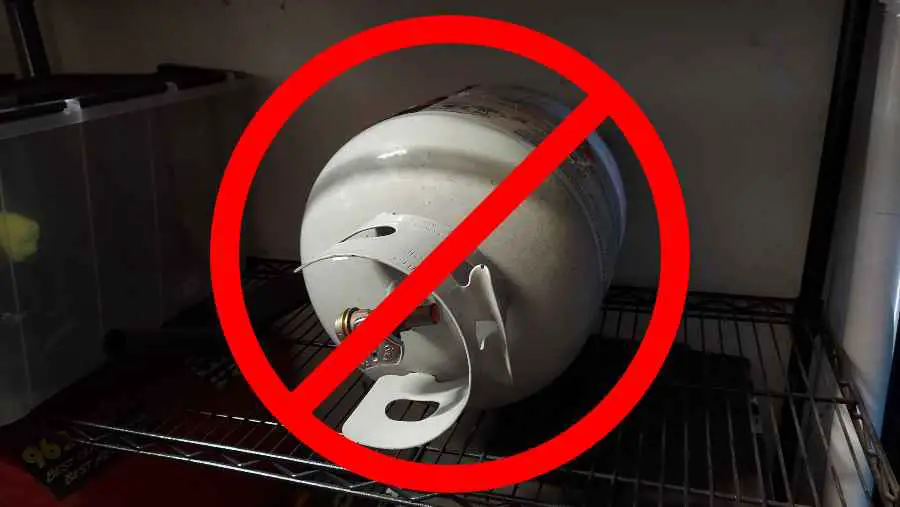
You should never lay a propane tank on its side unless it was specifically manufactured to operate horizontally. If you’re not sure if your propane can operate horizontally, click here.
Let’s go over in more detail what happens when you lap a propane tank on its side, and why should never do so. I’ll also go over what propane tanks can lay on their side, and how to safely transport propane tanks.
What Happens When A Propane Tank Is On Its Side
Before I go over why you shouldn’t lay a propane tank on its side, let’s go over how propane tanks work and why liquid propane is dangerous. Since the main reason laying a propane tank on its side is dangerous is because of the possible exposure to liquid propane, it’s important to understand some basic details about how it could leak out and what can happen if you come in contact with it.
How Propane Tanks Work
Propane tanks work by maintaining a high level of pressure in order to keep the propane in its liquid form, allowing much larger quantities of energy to be stored. When an appliance is connected to a propane tank, the higher pressure inside the tank forces vaporized propane out of the valve and through the regulator/hose and into your appliance where it is burned.
When the appliance is using this vaporized propane, the pressure inside the tank decreases. As the pressure inside the tank decreases, the propane begins to boil and becomes a vaporized gas which then maintains the pressure inside the tank. Even after you turn your appliance off, the liquid propane inside your tank will continue to boil until the pressure equalizes and no more vapor can form inside the tank, typically this is between 100-200 PSI depending on temperature.
Below is a video demonstration of what is happening inside your propane tank as it operates.
Propane Leaks – Vertical vs Horizontal
Propane vapor is extremely flammable, and a gallon of liquid propane contains roughly 91,000 BTUs. Typically, if a propane leak were to occur while the tank is standing vertically, only a small amount of gaseous vapor would be released since the valve is at the top of the tank and only in contact with propane vapor.
However, if a liquid propane leak were to occur due to the propane tank laying on its side, a much larger amount of potential energy would be released since the valve would be submerged and liquid propane would leak out.
Since propane boils at -44°F, if the ambient temperature is above this it will boil and create gaseous propane vapor, otherwise, it will remain a liquid. When propane boils, it expands to 270 times its liquid volume, so as you can see, a liquid propane leak can release a lot more potential energy and create a very dangerous situation.
To get a visualization of how much a liquid can expand when vaporized, imagine you have a gallon of water. If you were to boil that gallon, and store all of the water vapor in gallon jugs, it would take 1,321 gallons to contain all of the vapor.
Dangers of Liquid Propane
Along with the obvious dangers of propane being extremely flammable, liquid propane is extremely cold. If you are exposed to it and get in on your skin, you will most likely get frostbite damage.
When liquid propane boils, it creates propane vapor. This vapor is actually heavier than air, so if there is a leak, the liquid propane will produce a large amount of propane vapor that can go undetected as it sits on the floor. In an enclosed space, this can create the potential for fire hazards and explosions. This is why you should never store propane tanks on their side, as a propane leak could easily go undetected.
While it’s not advisable to store or have your propane tank on its side, if you tip your propane tank over or hold it sideways, liquid propane won’t just come pouring out as long as there isn’t a leak. This is because of the Overfill Protection Device on your propane tank, which is the valve on the top of the tank.
However, if the OPD malfunctions, there is damage to the device, an open connection, or the safety relief valve was to open, liquid propane could escape the tank. And if you have a regulator/hose connected, you could get liquid propane inside the regulator causing it to freeze. Check out my article on how to fix a frozen regulator for more information on that.
Let’s go over more details about the OPD valve so you have a better idea of how it works.
Propane Tank Overfill Protection Device (OPD)
The Overfill protection device or OPD is the top valve on a propane tank, it contains the main handwheel for opening and closing the flow of propane out of the tank, as well as multiple other features.
Mainly, it has a bleeder valve for manually purging the tank, a safety relief valve that automatically triggers when the pressure inside the tank gets too high, and a long float device that goes inside the tank and stops the tank from being overfilled. You can see these parts (excluding the float device that’s inside the tank) in the picture below.
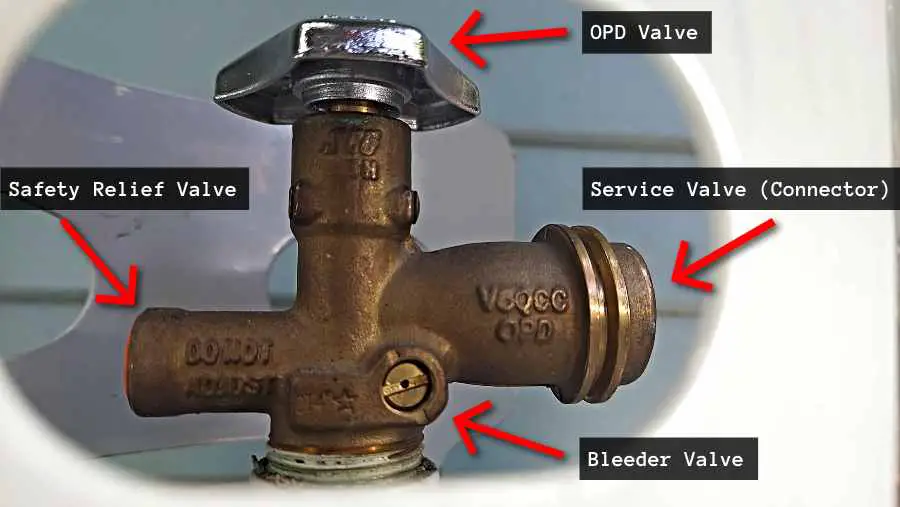
When laid sideways, the hose that connects to the bleeder valve will become submerged. The bleeder valve is typically used when filling propane tanks to signify when the tank is at 80% capacity, or full, and usually only has vaporized propane in it. If the bleeder valve were to be open or loose, liquid propane could leak out of this hole.
Similarly, the safety relief valve is a safety feature that activates when the pressure inside of the tank exceeds a certain amount. If this were to happen while your propane tank is sideways, you could experience liquid propane trying to exit the safety relief valve. This could potentially trigger if the tank were to be left in a hot car, or the tank was full and the ambient temperature increased.
Now, while you shouldn’t ever lay a propane tank on its side or transport a propane tank sideways, this does not apply to all propane tanks. Some propane tanks are actually manufactured to operate horizontally.
Horizontal Propane Tanks (Okay On Their Side)
The only time you should lay a propane tank on its side or transport a propane tank horizontally is when the tank was manufactured to operate horizontally. Propane tanks that are mounted on their side look different than typical vertical cylinders, as the valve is off center and the frame around the top of the tank will look different than a vertical one. These propane tanks can typically operate vertically or horizontally. If you’re unsure which propane tank you have, review the image below. However, chances are you have a standard vertical tank and horizontal tanks are a lot less common.

Depending on how you are using your propane tank, you may want to purchase a horizontal propane tank. These tanks can usually be mounted to RVs or trucks and may be easier for you to transport safely.
Horizontal propane tanks typically cost more than vertical ones, and will mostly need to be refilled and cannot be exchanged. Flame King makes a 20lb horizontal propane tank which you can find on Amazon. It comes with a gauge and can operate both horizontally and vertically, making it very versatile. You can also reach out to your local hardware store or propane supplier to see what horizontal options they have available and what the costs associated with them are.
Transporting Propane Tanks
The main reason I actually wrote this article was when I had to google a question about transporting propane tanks, and saw a lot of questions about if you can transport propane tanks horizontally.
Some of the larger sizes, such as 100 lb propane tanks can be difficult to transport vertically due to their size, so you’d assume you could transport them laying down, however, you should still transport these vertically. You’ll need to find a way to secure the tank vertically in the bed of a truck or rear cabin.
Always make sure to follow propane transport safety guidelines like having the windows down and all valves closed and any appliances disconnected. Below are some tips for transporting propane tanks, but for more details on transporting propane tanks check out my article on how to dispose of propane tanks which goes into more detail on this.
When transporting a propane tank make sure to:
Always:
- Always transport propane tanks vertically and make sure they are secured
- Always ensure the valve is fully closed, and nothing is attached to the tank
- Always keep the tank in a well-ventilated space, preferably in the bed of a truck
- If you have to transport the tank in the passenger area of a car, place it in the backseat and secure it with a seatbelt and have your windows rolled down
Never:
- Never leave the tank in a hot car. If it gets too hot it can trigger the pressure relief valve, which will fill your car with propane
- Never transport propane tanks on their side
- Never smoke near propane tanks (see video below)
- Never transport propane tanks in the trunk of a car
Failure to follow these safety tips when transporting can lead to serious injury or even death.
In Closing
Let’s go over some of the basics from this article:
- Propane tanks should never be laid on their side
- Only propane tanks manufactured to operate horizontally can lay on their side
- 100 lb propane tanks should not lay on their sides, even when being transported
- The reason you can’t lay them sideways is the danger of liquid propane leaking
- Exposure to liquid propane can cause frostbite, and release large amounts of propane vapor
Hopefully you found this information informative, and if you have any comments or questions please feel free to reach out.
Thank you and God Bless!

